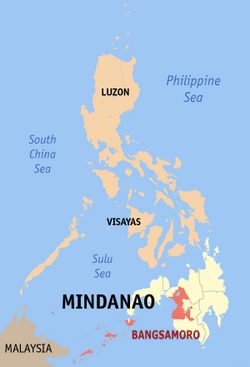Sapa-Sapa ساڤ-ساڤ | |
|---|---|
| Municipality of Sapa-Sapa | |
 Map of Tawi-Tawi with Sapa-Sapa highlighted | |
Location within the Philippines | |
| Coordinates: 5°05′24″N120°16′22″E / 5.089897°N 120.272875°E | |
| Country | Philippines |
| Region | Bangsamoro Autonomous Region in Muslim Mindanao |
| Province | Tawi-Tawi |
| District | Lone district |
| Barangays | 23 (see Barangays) |
| Government | |
| • Type | Sangguniang Bayan |
| • Mayor | Rhodesia M. Sali |
| • Vice Mayor | Karim Darwis J. Masdal |
| • Representative | Dimszar M. Sali |
| • Municipal Council | Members |
| • Electorate | 22,022 voters (2025) |
| Area | |
• Total | 235.61 km2 (90.97 sq mi) |
| Elevation | 5.0 m (16.4 ft) |
| Highest elevation | 529 m (1,736 ft) |
| Lowest elevation | 0 m (0 ft) |
| Population (2020 census) [3] | |
• Total | 33,580 |
| • Density | 140/km2 (370/sq mi) |
| • Households | 5,548 |
| Economy | |
| • Income class | 3rd municipal income class |
| • Poverty incidence | 37.19 |
| • Revenue | ₱ 204.4 million (2022) |
| • Assets | ₱ 159.3 million (2022) |
| • Expenditure | ₱ 180.2 million (2022) |
| • Liabilities | ₱ 1.407 million (2022) |
| Service provider | |
| • Electricity | Tawi Tawi Electric Cooperative (TAWELCO) |
| Time zone | UTC+8 (PST) |
| ZIP code | 7503 |
| PSGC | |
| IDD : area code | +63 (0)68 |
| Native languages | Sama Tagalog |
| Website | www |
Sapa-Sapa, officially the Municipality of Sapa-Sapa (Tagalog : Bayan ng Sapa-Sapa), is a municipality in the province of Tawi-Tawi, Philippines. According to the 2020 census, it has a population of 33,580. [3]



